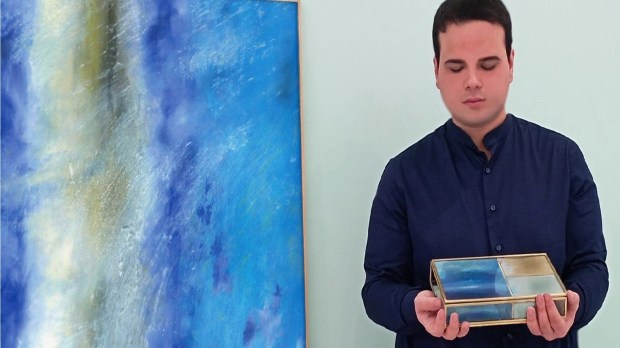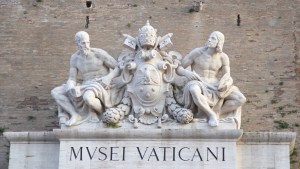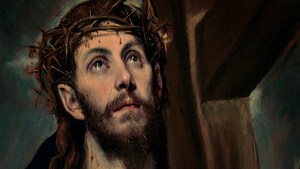The Italian artist Giovanni Guida has been deemed the heir of Max Ernst, because of his original use of grattage – a technique that consists of “scratching” fresh pigment, on a prepared support, with a sharp blade. The idea, oftentimes used by surrealist painters, is to “move” the surface of the composition, making it more dynamic.
There are reasons behind this technical choice. Guida’s grattage involves tearing the paint, as if evoking the tearing of the veil of the Temple. The movement is rather clear: the tearing goes from above (that is, from the divine, the transcendent) to below (to our all-too-human reality). His use of color also stresses this tension. The blue found in his work (a “heavenly” blue that emulates Byzantine blue) points at the crossroads between a natural here and a supernatural there.
In that sense, his art can be considered contemplative, meditative – even theological. Aleteia had the opportunity to interview the young artist and discuss sacred art, the search for beauty and truth, current artistic trends, and “setting out into the deep.” [Interview edited for length and clarity.]
Your art has been described as hierophanic. How is contemporary art able to manifest the sacred? It is obviously not a matter of subject matters, since most of your art tends towards abstraction.
Giovanni Guida: My art becomes hierophanic at the moment in which the veil of the skin of the painting is torn in order to make visible the genesis of things, the world in its nascent state. This action is “revealing” because there is the sudden irruption of the absolute reality of the sacred which, transcending this world, manifests itself and therefore sublimates it, sanctifies it, and makes it real. When the color is freed from the successive superpositions of chromatic layers and brought back to its brilliance and primordial purity — through awls that become tools to reach the “Great Beauty” — we arrive at a sort of “spiritual transcendence” of perception; there is the desire to free oneself from matter, to no longer have vanishing points and limits, to strive for and achieve the impossible. This action involves the “penetration” of the spiritual universe, the profound general knowledge of man, the active observation of internal processes, that movement which from below tends upwards, from history to eternity.
It is not possible to conceptually describe how contemporary art manages to manifest the sacred: faced with the exceptional nature of this manifestation, which goes beyond the usual and the ordinary, the artist should simply feel questioned, challenged and thus begin that path of linear progress which is achieved in the attempt to implement a dialogue between man and the Absolute, with a reverential feeling in the face of the infinite as a numinous “mysterium tremendum et fascinans,” which disconcerts reason, shocks and arouses wonder and amazement.
In your work, the color blue seems to play more or less the same role played in Byzantine art. This is, in my understanding, a movement going from the metaphysic into nature. Could you say more about your palette?
Giovanni Guida: Yes, it is a movement that proceeds from transcendence to immanence, almost as if it were a gift from above to be preserved and valorised; matter is recalled without representing it (without making it present): the Absolute that opens up to the human, leading to a cult of the immaterial, of the invisible, a sublimation of color in a suprahistorical dimension (the revelation of the principle of internal necessity through color dimension).
My works are characterized by the depth of the noble blue of lapis lazuli — which projects beyond the human, between apotheosis and glory that have no dimension: the spiritual overseas that seeks the infinite, the Divinity, the vital breath, meditation and revelation (we witness a transubstantiatio, a transubstantiation of color that is effectively transformed into art through the union between heaven and earth in search of a cosmic embrace); from the silver, which recalls the refinement of the precious sculptures of sacred goldsmiths (reliquaries, Evangeliarium — gospel books, liturgical furnishings); and from the gold, which recalls the alliance between the Absolute and man, the “metaphysics of light,” the incorruptibility and eternity of art.
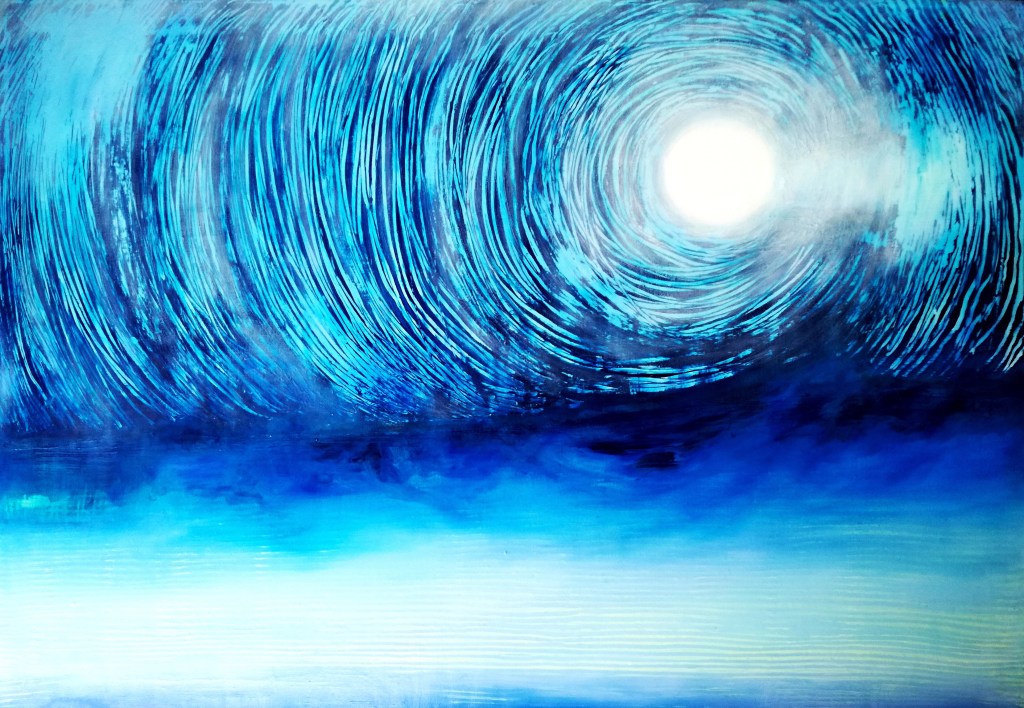
It often seems that, since Chagall and Rothko, we have not seen much of a resurgence of the spiritual in art. In your opinion, what’s the place of sacred art in today’s art world?
Giovanni Guida: In this liquid society (as the philosopher Zygmunt Bauman defines it) there is a fracture between art and faith. Paul VI in 1964, addressing artists, said: “We need you.” This phrase brought out a sense of guilt and abandonment in a world that had emancipated itself, with autonomous, independent paths. I believe that all “true art” is already sacred as an expression of man who, deeply rooted in the reality in which he lives, opens up to the dimension of an “elsewhere”; in my opinion, the term “Sacred” is not specific to Christian art but is related to every aesthetic expression that deals in depth with the theme of the human. I think that this sacredness is what we consider the “great beauty” because every true artist is searching for beauty, a place of density of meaning, a depth of meaning, of a significant product within our culture, placing himself in listening a mystery by which man feels questioned.
It is also true, on the other hand, that intellectuals and artists have turned to biblically-inspired philosophy (and even to biblical and theological literature) to examine their work, and make sense of the current moment. Would you say that’s part of your own discipline as an artist?
Giovanni Guida: Of course; I seek biblically inspired philosophy to give meaning to my work in order to implement a metacognitive activity of self-evaluation and self-correction. In particular I am inspired by the philosophy of Augustine of Hippo, an exponent of patristics. His famous phrase Noli foras ire, in te ipsum redi, in interiore homine habitat veritas, which invites us to return to ourselves because the truth dwells within man is the constitutive model of my life’s project.
Quid est veritas? What is the truth? this search for the truth symbolically connects me to the famous veil of the temple of Jerusalem, that enormous curtain that divided the part intended for the priests from the inaccessible part (reserved for the High Priest, a man of great spirituality) where the relic containing the reflection of the “hand of God,” the Ark of the Covenant. When the “King of Kings,” Rex Iudaeorum, died on the cross, this veil was torn in two, from above (transcendence) to below (immanence). The evangelist Luke tells us that the veil was torn in the middle; it is exciting to note how this laceration ideally refers to the penetration of the pictorial film through the Grattage technique; the artist who meets the Absolute halfway, at the center, in order to make the veil fall and disappear from our eyes and experience the truth.
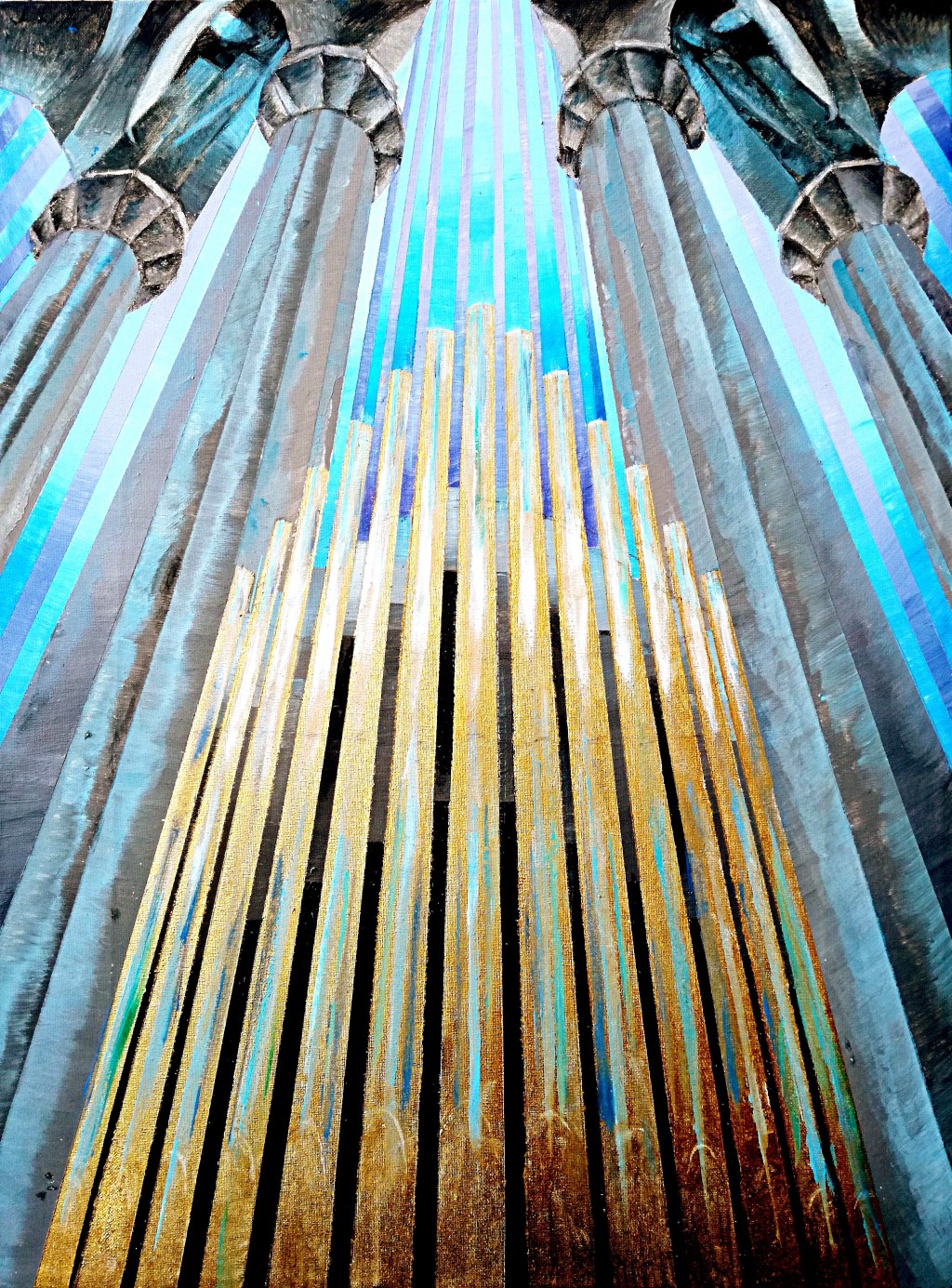
What are you currently working on? Where is your research taking you now, both in terms of techniques and subject matters?
Giovanni Guida: There are new territories to explore; we need to unhinge, innovate and reinvent (thought and technique), looking at everything from a different perspective, angle. The objective is to “set out into the deep” (Duc in altum), decentralize myself from the world and system of contemporary art and not necessarily adhere to the conventions, convergences, rituals and stereotypes of the present. Being visionary, seizing the future before it happens and opening up to divergence, to globality, to the totality of things. Art should emerge from static, delimited realities: the world must become a widespread museum, which will no longer have walls, it will be possible to see the heavens open and torn (like the vision of the protomartyr Stephen) and there will no longer be structures, cages and definitions. The “Great Beauty” cannot be questioned but reigns by divine right; only by transforming our life into a work of art, making our existence authentic, singular, concrete and worth living, can we penetrate our “principium individuationis” and give ourselves to others.
